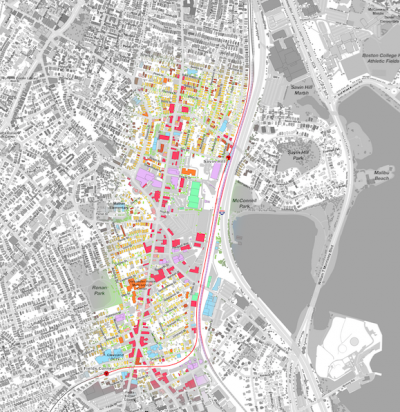January 5, 2017
With a South Boston planning study for its stretch of Dorchester Avenue moving on to the zoning stage, the Boston Planning and Development Agency (BPDA) is turning its sights onto the Glover’s Corner area along the avenue in in Dorchester.
City officials say they expect to begin outreach to the community in the next month or two to set the stage for the re-framing of the neighborhood, with an emphasis on the swatch of largely industrial property along the Freeport Street corridor.
Mayor Martin Walsh announced the planning initiative, along with one for Roxbury’s Dudley Square, at his State of the City speech last January. As the administration seeks to add 53,000 new housing units to the city’s rolls by 2030, the focus is on identifying spots for growth in balance with local priorities for housing, commercial, and open spaces.
 Glover's Corner planning study: Though without strict boundaries at this stage, the plan will likely stretch along the Dorchester Avenue corridor and focus its impact on industrial areas. Jennifer Smith photoThe study area has “preliminary boundaries,” said Lara Mérida, BPDA deputy director for community planning. Centered around the Dorchester Avenue stretch in Glover’s Corner, the zone will touch Clam Point, Hancock, Bowdoin Geneva, Fields Corner, and Savin Hill, even if it doesn’t delve fully into the respective villages.
Glover's Corner planning study: Though without strict boundaries at this stage, the plan will likely stretch along the Dorchester Avenue corridor and focus its impact on industrial areas. Jennifer Smith photoThe study area has “preliminary boundaries,” said Lara Mérida, BPDA deputy director for community planning. Centered around the Dorchester Avenue stretch in Glover’s Corner, the zone will touch Clam Point, Hancock, Bowdoin Geneva, Fields Corner, and Savin Hill, even if it doesn’t delve fully into the respective villages.
“The main focus will be the industrial area we’re looking at,” she said, “but of course we want to be considerate of whatever happens to that industrial area, whether it stays industrial or moves into another use, and how that impacts the surrounding area.”
The Dot Block project, which recently secured a measure of financial backing, sits on about four acres of land bounded by Dorchester Avenue and Greenmount, Pleasant, and Hancock streets in the middle of the proposed study area. “That project will impact what happens in the area,” Mérida said, “so we’ll of course include that in our conversations.”
As has been the case in planning studies in South Boston and Jamaica Plain/Roxbury, industrial land in the Glover’s Corner study area could be set up to be rezoned for higher-density mixed-use or residential development. Zoning recommendations will be made “surgically,” Mérida said, noting the lack of comprehensive neighborhood zoning for the past few years.
But the process will be flexible, she emphasized. The BPDA expects to kick things off in February with an open house of sorts where the agency will share what they’ve gathered as far as demographics, neighborhood specifications, topology, and the businesses and residences that would be affected by the study.
“In that conversation,” Mérida said, “we’ll look at a boundary together in partnership with the community to think through what makes sense, what’s the growth area, what’s the potential growth area, what are potential areas we want to preserve, and where are places we really want to enhance, such as public ground, streets, sidewalks, and so forth.”
A community advisory group, gathered through a nomination process and signed off on by the mayor, will be set up to help bridge the neighborhood-planner gap. Elected officials and community members will have the opportunity to nominate advisory members. Generally, Mérida said, the planning is expected to take nine or ten months, with much of the timing dependent on interactions with the community.
“When you get into these neighborhoods and you plan, the outcomes are sometimes not predictable,” said Michael Christopher, the BPDA’s deputy director of development review. “So you have to be flexible with the timeline.”
The South Boston and Jamaica Plain/Roxbury plans, both launched in the summer of 2015, are seeing varying levels of support.
Votes on the “JP/Rox” plan were delayed several times last year over neighborhood concerns about density. The BPDA approved the plan for Dorchester Avenue in South Boston last month, moving it into “the implementation stage,” Mérida said, with zoning discussions next on the agenda.
The Glover’s Corner project will have two senior planners devoted full time to the effort and three floating junior planners for support, with other city housing, economic, and transit departments also involved. Mérida said the agency anticipates the need for outside traffic consultants and maybe an economist.
BPDA officials said the bulk of the conversations inevitably will be spent on getting the planning teams and the community on the same page, feeling their way forward together.
“We’re aggressively planning, which is something we haven’t really done in the city,” Christopher said.
“Don’t get me wrong; we’ve always planned, but [we’re going] as far as really targeting areas and going out and having tough dialogue, but productive dialogue and, we think, rewarding dialogue at the end of the day.”



